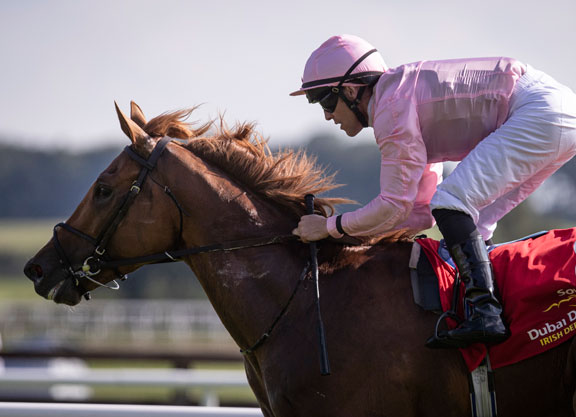By Andrew Caulfield
In the story of Coolmore's emergence as arguably the world's most important stallion station, Kilsheelan Stud would barely merit a footnote. For a while this satellite stud was used to house a few of Coolmore's National Hunt stallions, such as Executive Perk and Carlingford Castle, as well as some inexpensive speed sires, such as College Chapel and Distinctly North. However, that footnote became essential at the end of 1997, when Danehill Dancer returned from his first season in Australia to make his Irish debut at Kilsheelan.
Danehill Dancer's services were priced at only IR4,000gns. This made him comfortably the cheapest of the four Group 1 winners which were added to the Coolmore roster for the 1998 season, the others being the Sussex S. winner Ali-Royal, who was priced at 6,000gns, and the the 2,000 Guineas winner Entrepreneur and the Irish 2,000 Guineas and Irish Derby winner Desert King, both of whom retired at 17,500gns.
The level of Danehill Dancer's fee, and his location, suggested that expectations were not especially high, which might have been a reflection of the second half of his racing career. He had failed to finish closer than third in any of his final six appearances and his last two outings saw him finish last of 11 in the 1996 Haydock Park Sprint Cup and seventh of 10 in the 1997 Duke of York S. Retirement and a first trip to Australia soon followed.
Of course, there was another side to his story. His first five appearances had yielded four victories and a second. He had landed the G1 Phoenix S. on only his second appearance and then followed up with another Group 1 success in the National S. He had also made a bright start to his second season, winning the G3 Greenham S. to earn a shot at the 2,000 Guineas, in which he gave the impression that a mile was a step too far.
Fortunately, Danehill Dancer immediately dispelled any doubts about his potential as a stallion, in much the same way that his own sire, Danehill, had done, and he was soon switched to the main stud farm. Only Danehill's 2-year-olds won more races in 2001 than the British and Irish members of Danehill Dancer's first crop and by 2006 Danehill Dancer had emulated Danehill by becoming the leading sire of 2-year-olds.
He was to top the table again in 2008 and 2009. With his success being by no means restricted to his juveniles, Danehill Dancer also took the title of champion sire in 2009, having been runner-up to Galileo in 2008.
To round off his accomplishments, Danehill Dancer also defeated Danehill to become the champion sire of broodmares in 2016 and he is again doing tremendously well in this role, to the extent that he now ranks second to Pivotal, one place above Galileo.
An odd aspect to Danehill Dancer's career as a broodmare sire was that, at one stage, his daughters had produced northern hemisphere Group 1 winners to only one sire–Galileo. That changed when Dubawi's daughter Kitesurf triumphed in last year's Prix Vermeille, but it has been more of the same this year. Firstly we saw the G1 St James's Palace S. fall to Circus Maximus and then we had the shock of Sovereign proving impossible to catch in the G1 Irish Derby.
Sovereign ranks as the third Classic winner produced by the Galileo-Danehill Dancer nick, following the magnificent Minding, who numbered the 1,000 Guineas and Oaks among her seven Group 1 successes, and The Gurkha, who landed the Poule d'Essai des Poulains. The other Group 1 winner from this cross was that tough and talented filly Alice Springs, who landed the Falmouth, Matron and Sun Chariot S. during a busy campaign in 2016. (Incidentally, Alice Springs' first foal is a 2019 filly by Dubawi.)
Breeders didn't lack motivation for sending Danehill Dancer's daughters to Galileo. With the Group 1 winners Teofilo, Cima de Triomphe, Frankel, Golden Lilac and Roderic O'Connor among the early representatives of Galileo's association with Danehill, there was every incentive to try the multiple champion sire with Danehill's grand-daughters, especially those by Danehill Dancer. Galileo's partnership with Danehill's daughters has continued to flourish to the extent that there are now more than 60 black-type earners among its 303 foals of racing age. No fewer than 49 of them have become black-type winners, for a terrific 16 per cent.
To be honest, I didn't expect Danehill Dancer's daughters to match up to those of Danehill. While Danehill Dancer was clearly a highly accomplished stallion, and a versatile one too, he made much less impact than his sire in his 13 visits to Australia and Danehill also notched up more sires' championships in Europe. However, with quite a few of Danehill Dancer's daughters having access to the world's most brilliant stallion, they too have achieved some remarkable figures. From 107 foals of racing age, they have produced 19 black-type winners, which represents 18 per cent, compared to Danehill's 16. Their 14 Group winners represent 13 percent, compared to the 11 percent Galileo has achieved with Danehill mares. Both figures compare well with Galileo's worldwide figure of around 7 percent group winners to foals.
It is worth looking at the racing records of the Danehill Dancer mares responsible for group winners by Galileo. Oddly, the one with the best record is Remember When, who never won a race despite being good enough to finish fourth in the Irish 1,000 Guineas and second to Snow Fairy in the Oaks. All seven of Remember When's foals are by Galileo and all four of her runners are black-type winners, namely the Group 2 winner Wedding Vow (second in the G1 Nassau S.), the Group 3 winners Beacon Rock and Bye Bye Baby (who was third in the Oaks) and the listed winner Bound, who was sold for 2,200,000gns last December.
Most of the other group winners bred this way are also out of mares which were well above average. Minding and her Group 3-winning sister Kissed By Angels are out of the Group 1-winning Lillie Langtry, whereas Circus Maximus' dam Duntle was demoted to second after her win at Group 1 level. The Group 2 winner Memory is the dam of Group 2 winner Call To Mind and Group 3 winner Recorder, and The Gurkha's dam Chintz was a Group 3 winner. Alice Springs' dam Aleagueoftheirown was second at Listed level, as was Longing To Dance, the dam of Group 3 winner Be My Gal. That leaves the Group 3-winning Quest For Peace, who is out of a minor winner, and the Group 3 winner Rain Goddess, who is the only other one of the 14 to have a non-winning dam. Even she has the Classic-winning Virginia Waters as her second dam.
Sovereign's dam Devoted To You was also well above average, as she showed when second to Lillie Langtry in the G2 Debutante S. at two and when she was beaten only a head in the G3 Park Express S. on her reappearance at three. She also put up a couple of respectable efforts at around a mile and a quarter. Coincidentally, Sovereign's unraced second dam Alleged Devotion was a half-sister to Balanchine, the Oaks winner who defeated the colts in the Irish Derby. This excellent family also produced the Prix de Diane winner West Wind, whose half-sister Eastern Joy is the dam of the high-class Thunder Snow.
Not a subscriber? Click here to sign up for the daily PDF or alerts.






